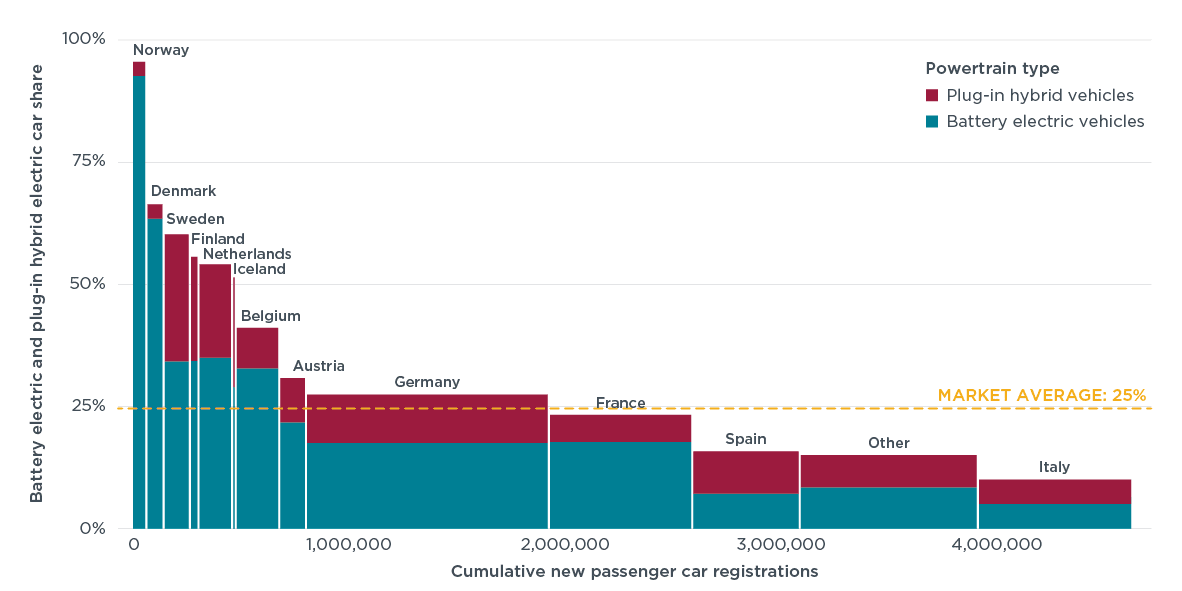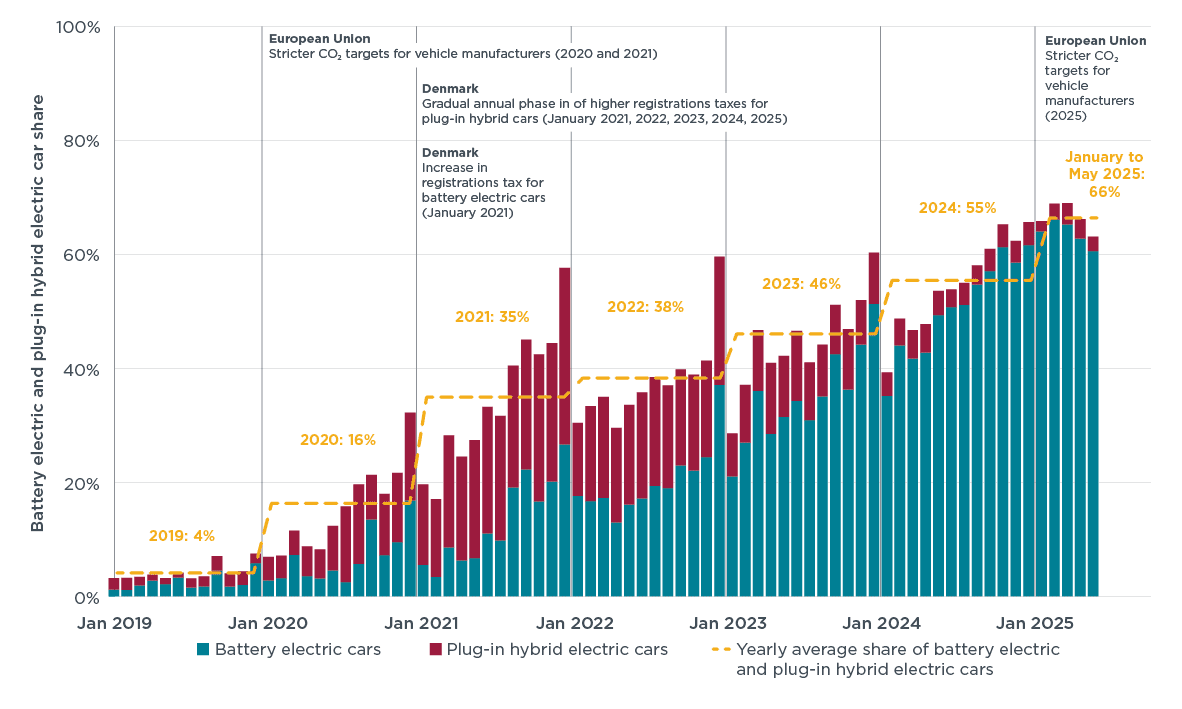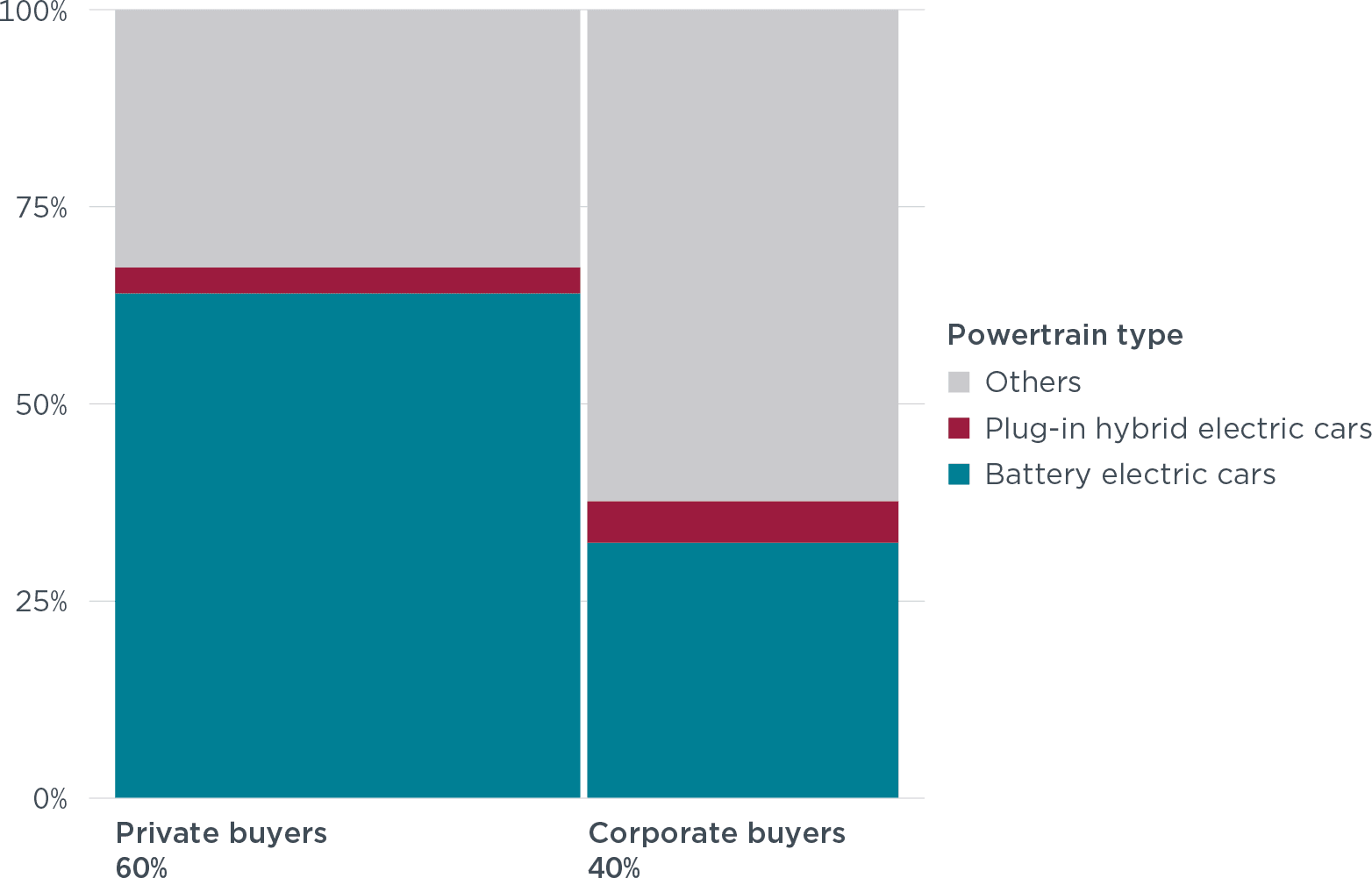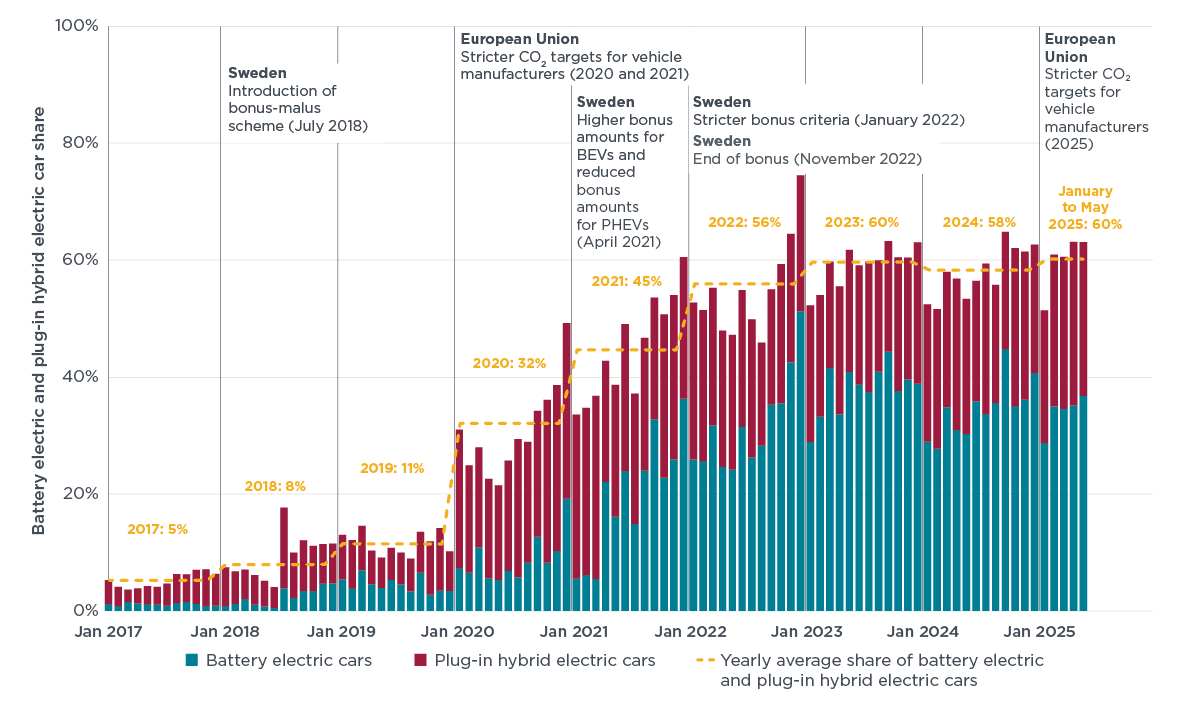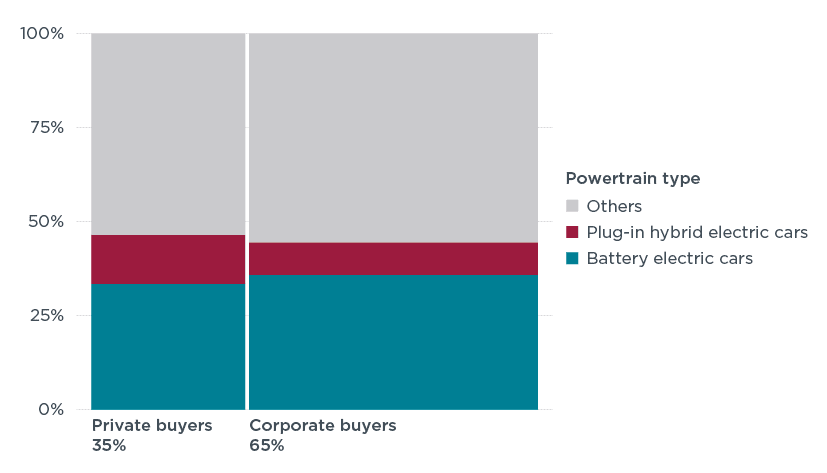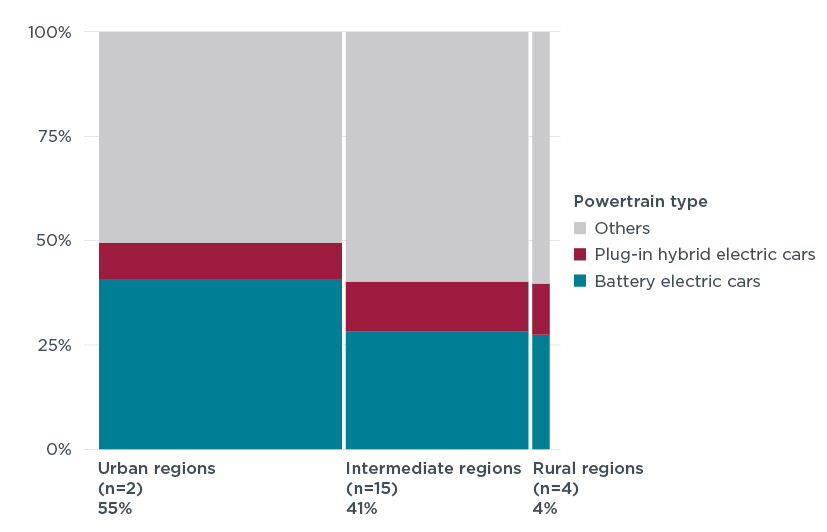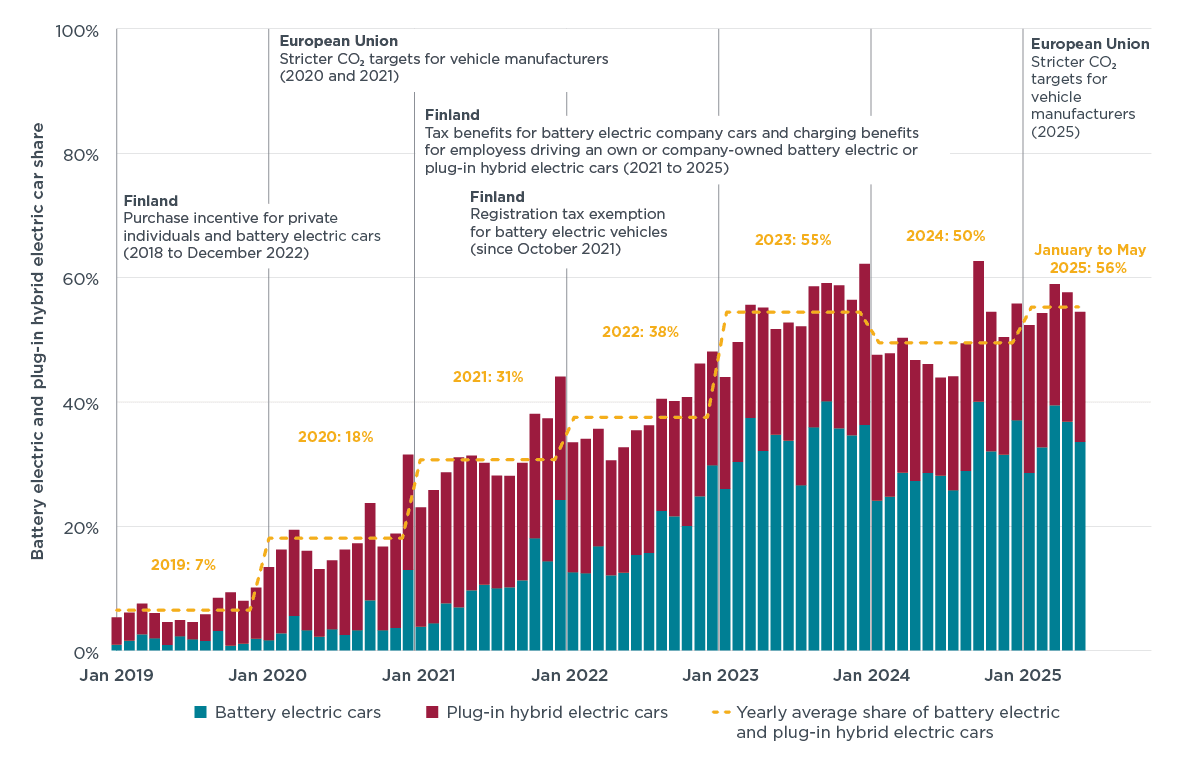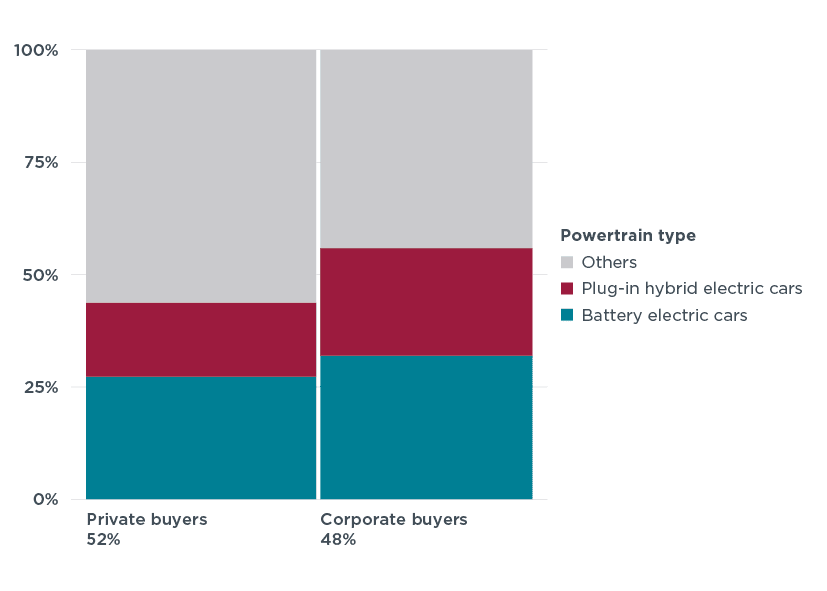Market Spotlight
Europe’s electric vehicle market leaders: Denmark, Sweden, and Finland
Electric passenger car market in Europe
Figure 1. Total new car registrations and share of BEV and PHEV passenger cars by country, January to May 2025
Denmark
Market trends, January–May 2025In the first five months of 2025, EVs made up 66% of new car registrations in Denmark; among new passenger car registrations, 63% were BEVs and 3% PHEVs. Compared with January to May 2024, BEV registrations rose by 55% while PHEV registrations fell by 34%. The total passenger car market growth grew more modestly than the BEV market, increasing by only 6%.
Table 1. New BEV and PHEV passenger car registrations in Denmark
| Denmark | January to May 2025 | Change from January to May 2024 | ||||
| BEV | PHEV | Total | BEV | PHEV | Total | |
| Total | 45,013 | 2,063 | 70,906 | +55% | -34% | +6% |
The EV share of new passenger car registrations in Denmark increased by 12 percentage points between 2019 and 2020 and by 19 percentage points between 2020 and 2021. The monthly average share reached 16% in 2020 and 35% in 2021. In 2024, EVs accounted for more than half of new car registrations.
Figure 2. Share of BEVs and PHEVs in new passenger car registrations in Denmark and selected policy actions
Table 2. Top 10 newly registered BEV models in Denmark, 2024
| Rank | Brand | Model | Units sold | Segment |
| 1 | Tesla | Model Y | 10,471 | SUV |
| 2 | Škoda | Enyaq iV | 5,654 | SUV |
| 3 | Volkswagen | ID.4 | 5,652 | SUV |
| 4 | Tesla | Model 3 | 5,527 | Medium |
| 5 | Audi | Q4 e-tron | 5,307 | SUV |
| 6 | Peugeot | 208 | 3,036 | Small |
| 7 | Volkswagen | T-Roc | 2,987 | SUV |
| 8 | Volkswagen | ID.3 | 2,930 | Medium |
| 9 | BMW | 3 Series | 2,855 | Medium |
| 10 | Nissan | Qashqai | 2,762 | SUV |
Selected national-level drivers of EV uptake
- Tax incentives for EV purchases. Unlike many other leading markets, Denmark has not provided EV purchase subsidies, instead seeking to spur EV adoption through tax breaks on EV registration.iii For non-EVs, Denmark implements a progressive vehicle registration tax, with rates increasing up to 150% on the portion of the vehicle price above a certain threshold.iv Through 2025, purchasers of BEVs pay only 40% of this standard registration tax, a rate that will increase gradually to reach 100% by 2035. An additional deduction of DKK 165,000 (about Є22,000) from the registration fee applies after the 40%, meaning purchasers pay little to no registration tax. For example, the registration tax difference between a small BEV and a small gasoline car is nearly Є14,000, the largest tax break among 31 European countries assessed (including the EU-27 plus Iceland, Norway, Switzerland, and the United Kingdom).
- Public charging infrastructure and home charging potential. Denmark recorded the highest growth in public direct current (DC) fast chargers in Europe in the first quarter of 2025, with a 104% increase compared with the same period in 2024.vi Dwelling patterns in Denmark also support broad access to home charging: As of 2023, 66% of Danes lived in detached or semi-detached houses, increasing to 77% in intermediate regions and 88% in rural regions, relative to an EU average of 52%.
Sweden
Market trends, January–May 2025
In the first five months of 2025, EVs accounted for 60% of new passenger car registrations in Sweden; among new passenger car registrations, 34% were BEVs and 26% were PHEVs. Compared with the same period in 2024, BEV registrations increased by 18% and PHEVs by 15%, and the total passenger car market grew by 6%.
Table 3. New battery electric and plug-in hybrid passenger car registrations in Sweden
| Sweden | January to May 2025 | Change from January to May 2024 | ||||
| BEV | PHEV | Total | BEV | PHEV | Total | |
| Total | 38,979 | 29,540 | 113,687 | +18% | +15% | +6% |
There has been a steady rise in EV uptake in Sweden since 2017, when PHEVs had a 4% share of the market and BEVs accounted for just 1%. From 2022, new registrations of BEVs began to consistently surpass registrations of PHEVs. By 2024, BEVs made up approximately 35% of all new passenger car registrations, compared with 23% for PHEVs.
Figure 4. Share of BEVs and PHEVs in new passenger car registrations in Sweden and selected policy actions
Figure 5. Share of BEVs and PHEVs in new passenger car registrations in Sweden by owner type, 2024
Table 4. Top 10 newly registered BEV models in Sweden, 2024
| Rank | Brand | Model | Units sold | Segment |
| 1 | Tesla |
Model Y |
18,293 |
SUV |
| 2 | Volvo | EX30 | 7,100 | SUV |
| 3 | Volvo | EX/XC40 | 6,165 | SUV |
| 4 |
Volkswagen |
ID.4 |
4,989 |
SUV |
| 5 | Polestar | Polestar 2 | 4,245 | Medium |
| 6 |
Škoda |
Enyaq iV |
3,841 |
SUV |
| 7 | Tesla |
Model 3 |
3,477 |
Medium |
| 8 | Volvo | EC/C40 | 3,439 | SUV |
| 9 | Volkwagen | ID.7/ID.7 Tourer | 3,376 | Medium |
| 10 | Audi |
Q4 e-tron |
2,569 |
SUV |
Figure 6. Share of BEVs and PHEVs in new passenger car registrations in Sweden by regional typology, 2024
Selected national-level drivers of EV uptake
- National purchase incentives and tax policy. Sweden has long used purchase bonuses and tax incentives to promote EVs. While earlier schemes offered direct purchase incentives, the introduction of a bonus–malus tax system in 2018 further accelerated EV adoption by offering financial incentives for BEVs and low-emission vehicles (typically PHEVs) emitting up to 60 g CO₂/km while imposing higher ownership taxes in the first three years on high-emission vehicles. In 2021, the bonus for BEVs was increased, while the incentive for PHEVs was reduced. While the direct purchase bonus ended in 2022, ownership tax advantages for EVs and for electric company cars continue to promote EV adoption among both private individuals and businesses. For example, companies pay Є0 annually to own a small electric car versus Є400 for an equivalent gasoline car, the largest gap among 31 European countries surveyed.
- Public charging infrastructure and home charging potential. Sweden continues to expand its public charging infrastructure network. As of 2023, 51% of Swedes lived in detached and semi-detached houses, supporting potential access to home charging. However, only one third of new cars in 2024 were registered by private individuals.
- Geographic patterns: Most EV registrations are in urban regions with higher population density, though adoption is also notable in intermediate and rural regions. The share of EVs in new passenger car registrations in urban regions in 2024 was 9 percentage points higher than in intermediate and rural regions.
Finland
Market trends, January–May 2025
In the first five months of 2025, EVs accounted for 56% of new passenger car registrations; among new cars registered, 34% were BEVs and 21% were PHEVs. Compared with the same period in 2024, BEV registrations increased by 18%, while PHEV registrations declined by 6%. The total car market shrank by 8%.
Table 5. New battery electric and plug-in hybrid passenger car registrations in Finland
|
Finland |
January to May 2025 |
Change from January to May 2024 |
|||||
|
BEV |
PHEV |
Total |
BEV |
PHEV |
Total |
||
|
Total |
10,235 |
6,339 |
29,803 |
+18% |
-6% |
-8% |
|
Finland’s EV registration share rose by 11 percentage points between 2019 and 2020, and again by 13 percentage points between 2020 and 2021. The largest annual increase came between 2022 and 2023, when the EV share rose by 17 percentage points, from 38% to 55%. Although the annual EV registration share saw a slight decrease in 2024, BEVs and PHEVs still made up 50% of all new passenger car registrations that year.
Figure 7. Share of BEVs and PHEVs in new passenger car registrations in Finland and selected policy actions
Selected national-level drivers of EV uptake
- Purchase incentives and tax policy. In 2018, Finland introduced a €2,000 purchase subsidy for new BEVs, available only to private households. This scheme ended in December 2022. Purchasers and owners of BEVs and PHEVs have also benefited from lower registration and ownership taxes compared with combustion engine cars. Since October 2021, purchasers of a BEV have been fully exempted from vehicle registration tax. As an example, the registration tax advantage for a small BEV versus a small gasoline car is almost €2,000, the sixth highest among 31 European countries assessed.xi Owners of a BEV also benefit from minimum annual ownership tax rates. In addition, after-tax benefits on electric company cars support continued growth.
- Public charging infrastructure and home charging potential. Finland continues to expand its public charging infrastructure network. As of 2023, 62% of the population lived in detached or semi-detached homes with potential access to home charging.

